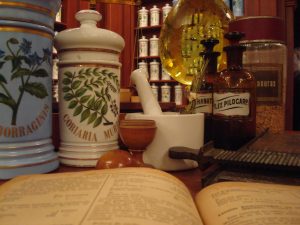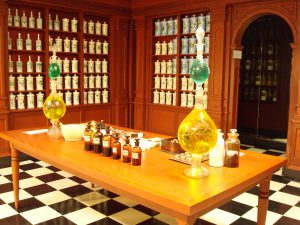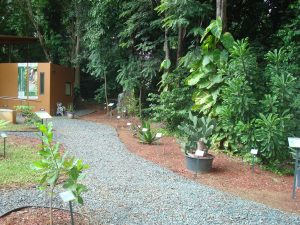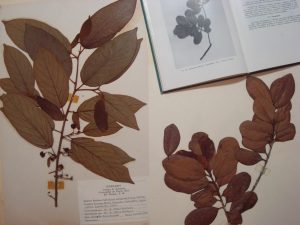The museum cares for two distinct collections: a collection of historical pharmaceutical artifacts, and a collection of living medicinal plants and herbarium.
Historical Collection
 The historical collection comprises the largest publically exhibited collection of different 19th century porcelain apothecary jars, each embellished with a painted reproduction of the medicinal plant it used to contain, and the botanical name of the plant, and of early 20th century glass apothecary bottles, labeled with the name of and the majority of them still containing a raw drug, drug product, ingredient or reactive. It also contains mortars and pestles, show globes, several other 19th and early 20th century pharmaceutical instruments, patented drugs, prescriptions, prescription formularies, pharmacopeias, regulatory documents, books, furniture and other memorabilia, for a total of nearly 1,000 collection objects. Nearly half of this collection is currently exhibited in the Dr. Luis Torres Díaz Hall, located in the first floor (lobby) of the Pharmacy and Students Deanships building, at the UPR Medical Sciences Campus in San Juan.
The historical collection comprises the largest publically exhibited collection of different 19th century porcelain apothecary jars, each embellished with a painted reproduction of the medicinal plant it used to contain, and the botanical name of the plant, and of early 20th century glass apothecary bottles, labeled with the name of and the majority of them still containing a raw drug, drug product, ingredient or reactive. It also contains mortars and pestles, show globes, several other 19th and early 20th century pharmaceutical instruments, patented drugs, prescriptions, prescription formularies, pharmacopeias, regulatory documents, books, furniture and other memorabilia, for a total of nearly 1,000 collection objects. Nearly half of this collection is currently exhibited in the Dr. Luis Torres Díaz Hall, located in the first floor (lobby) of the Pharmacy and Students Deanships building, at the UPR Medical Sciences Campus in San Juan.
Permanent Historical Exhibition
A permanent exhibition consisting of the representation of a traditional end of the 19th pharmacy in the island is presented. As it also used to be in Spanish pharmacies of the time, a baluster veranda separates the area for patients to wait for their medication, from the pharmacist’s working area, centered by a large table complete with show globes, mortars and pestles, a scale and other typical pharmaceutical instruments and references needed. This area is surrounded by beautiful handmade mahogany furniture embeded to the walls, where the porcelain apothecary jars collection, which reflect the raw drugs used to treat the diseases suffered by the Puerto Rican community at the time, is exhibited. It opens at the rear center to the “trasbotica”, where the glass apothecary bottles collection is kept. The exhibition also presents the classic “tertulias” or gatherings that used to take place in Puerto Rican pharmacies, where with drug jars, balances, mortars and pestles as a background, the town’s mayor, the priest, the teacher, the politician, and other community leaders met to discuss social, cultural or political matters, often with the pharmacist as moderator.

Medicinal Plants Collections
Living Medicinal Plants
The museum’s collection of living medicinal plants is exhibited in the Dr. Esteban Núñez Meléndez Medicinal Plants Garden, located within the University of Puerto Rico Botanical Garden, in San Juan. It includes most common native, endemic and exotic botanical species commonly used for medicinal pueposes by the Puerto Rican community, as referenced by its founder, Dr. Esteban Núñez Meléndez, and other researchers in their publications. Eleven concrete gardening boxes exhibit living aromatic plants; plants with alkaloids; plants under investigation by UPR researchers; edible plants, fruit trees and culinary herbs with therapeutic properties; and other plants with medicinal properties organized by their botanical families. Shrubs and trees also with medicinal properties are scattered around the less than an acre fenced piece of land. There are more than 150 different species, for a total of almost 400 specimens in the garden, labeled with their common name(s), botanical name and family, and scientifically evidenced or reported therapeutic properties. Also at the Medicinal Plants Garden, a temporary exhibition presents illustrative panels on the “Discovery and Development of Medicines from Plants”, which summarizes research on medicinal plants being currently done by UPR faculty; an audiovidual presentation on the history of the Medicinal Plants Garden; and a small display of specimens from Dr. Esteban Núñez Meléndez’s herbarium.


Herbarium
The museum also cares for the collection of nearly 600 dried and permanently preserved medicinal plants prepared by Dr. Esteban Núñez Meléndez in the 1950-60’s. Some specimens of this collection are currently exhibited at the Dr. Luis Torres Díaz Hall and some at the Medicinal Plants Garden. The rest of the collection is kept in the museum’s office at the School of Pharmacy.

